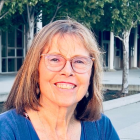Support strong Canadian climate journalism for 2025
Katharine Zywert’s just-completed PhD thesis shines a light on transformative approaches to health care that improve both human and planetary well-being.
This piece is part of a series of profiles highlighting young people across the country who are addressing the climate crisis. These extraordinary humans give me hope. I write these stories to pay it forward.
Tell us about your research.
Protecting and improving human health is our most basic goal. This requires a healthy planet. Right now, health care is seen to be just doctors and nurses and hospitals, but it needs to be delivered in ways that care for the whole person and the Earth at the same time. Caring for the environment is often dismissed as an expensive extra. A successful transition to a healthy future means measuring the worth of our activities, not by ever-increasing economic growth, but by the extent they protect and enhance our core values — human and environmental well-being. I interviewed 50 people in Europe, the United States, Australia, Canada, Mexico and the United Kingdom who are simultaneously providing both health and Earth care.

Can you give us some examples?
In many countries, “care farming” sees urban dwellers with addictions, disabilities or other mental health disorders gardening to produce food. In the process, their mental health improves, landscapes are revived and once marginalized people participate in the economy. Seen through this lens, farming is delivering health care.
Vermont-based Didi Pershouse started her working life as a health practitioner but realized she could make a bigger impact by learning how to help soil regenerate so it stores carbon, filters water, holds landscapes in place and provides nutrients for an entire food chain from what would otherwise be bare rock and desert sands. Didi is still caring for people’s health as a “soil sponge strategist,” demonstrating that caring for the soil can prevent forest fires and more rapidly remediate burned land. Healthy soil produces higher-quality food for healthier bodies. Fewer forest fires mean less air pollution.
In the town of Geel, Belgium, families volunteer to have someone with a serious mental illness live in their home. Boarders often live with their host families for decades. Our health-care system isn’t very good at supporting people with mental illnesses. In Geel, the health benefits come from boarders becoming valued, contributing members of their family. Families are compensated, but it’s much less expensive for the government than hospital-based care or other supportive living programs. Family care also has a much lower environmental footprint than a medical approach.
Nourish helps bring local and culturally appropriate food into hospitals, engaging health-care institutions in social justice and climate action. This improves patient well-being and encourages healthy and sustainable diets. Since Indigenous communities lead some of these interventions, their work also foregrounds self-determination.
Are there lessons we can draw from the common threads of these examples?
Economic growth is not a good metric for well-being. Those who described themselves as thriving are engaged in pursuing values of care for each other and their environments and building resilient communities. Their economic lives are sufficient and sustainable, but growth is not the goal. There is ample research to show once basic needs are met, chasing “more” is not the route to joy.
These projects tend to be multidisciplinary and intersectoral. Human activity is not segregated into “work” and “healthy leisure.” Mental health is not separated from physical well-being. Spiritual well-being is not separate from daily enterprise.
The vast majority of these projects are at the margins of mainstream institutions and economic systems. It is imperative to foreground the voices of marginalized people to learn from their experiences.

Are these ideas catching on in Canada?
They are reflected in the Six Principles for a Just Recovery. Thousands of Canadians in hundreds of organizations have called for the building of a much better world as we emerge from the pandemic. The first — Put people first. No exceptions — is just one example. If we did that, so much would change.
What drew you into this field?
My parents prioritized lives that aligned with their values over making money. When I was a kid, my dad started a small import business and travelled to South America and Asia to buy from local artisans. His travels taught me that there are many different ways to live a good life. I was also inspired by my grandmother, who left a job in the city to cultivate a rural garden and share it with others. Her garden brought bees, trees and birds back to land that had been clear-cut for logging. She was the first person to teach me how gardening can improve our health.
What makes your work hard?
It is sometimes frustrating to know that the world could be so much better, but the mythology driving our growth-dependent economy is pervasive.
What gives you hope?
Many brilliant people are engaged in this project and the world will be so much better when we all have our basic needs met and our planet is healing.
I also have a three-year-old. I have to believe there is a healthy future for him and I am not interested in putting any energy into things that don’t help.
What is next for you?
I am part of a great team at Openly, which seeks to increase our clients’ social and environmental impact.
What advice do you have for readers?
Design for the world you want to inhabit. A better world is limited only by our imaginations. Speak about your ideas and act on them. Humans are mimics. We need to see the changes sometimes to believe in them.






Comments